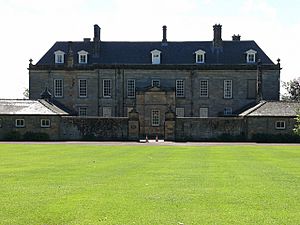Walter Blackett facts for kids
Sir Walter Calverley Blackett (born 18 December 1707, died 14 February 1777) was an important person in British history. He was a baronet, which is a special title passed down through families, and a politician. He worked in the House of Commons, which is a part of the British government, from 1734 until he died in 1777.
Contents
Early Life and Family Connections
Sir Walter Calverley Blackett was born Walter Calverley in a town called Otley. He was the only son of Sir Walter Calverley, 1st Baronet, and Julia Blackett. His mother's father was Sir William Blackett.
Education and Inheritance
When he was 16, Walter went to Balliol College, Oxford, a famous university. In 1728, he received a large inheritance from his uncle, Sir William Blackett, 2nd Baronet. This included big estates in Cambo and Allendale, Northumberland.
There was a special condition for this inheritance. He had to marry his uncle's daughter, Elizabeth Orde, within a year. He also had to change his last name to Blackett and use the coat of arms (family symbol) of the Blackett family. He married Elizabeth on 29 September 1729 in Newcastle. His name change to Blackett was officially approved by a special law in 1733.
A Life in Politics
Sir Walter was very active in politics and public service. He held many important roles during his life.
Serving Northumberland
From 1731 to 1732, he was the High Sheriff of Northumberland. This was an important local position, like a chief law enforcement officer for the county.
Member of Parliament
In 1734, he was chosen to be a Member of Parliament (MP) for Newcastle-upon-Tyne. He was a member of the Tory political party. He served in the British House of Commons for seven different periods, from 1734 until his death. This shows he was a very popular and trusted representative for his area.
Mayor of Newcastle
Sir Walter was also an Alderman (a senior member of the city council) for the City of Newcastle. He was elected Mayor of Newcastle five times! He served as Mayor in 1735, 1748, 1756, 1764, and 1771.
Helping the Community
He was known for being very generous in Newcastle. He helped build a library for the city. When the harbor froze, causing people to lose their jobs, he provided relief to help them. He also regularly supported the Newcastle Infirmary (a hospital) and helped local religious leaders.
Wallington Hall and Later Life
Sir Walter inherited a grand house in Newcastle called Pilgrim Street. In 1749, he also inherited his father's baronetcy and estates in Calverley and Esholt, Yorkshire. He soon sold the Yorkshire estates.
Improving Wallington Hall
He decided to live at Cambo, where he spent a lot of money improving Wallington Hall. He had the house redesigned in the popular Palladian style, which was a grand and balanced architectural look. The designs were made by an architect named Daniel Garrett. In 1755, he even asked Garrett to build a fake medieval castle, called Rothley Castle, on a hill near Wallington. This was a "folly," a building made for decoration rather than practical use.
End of a Line
Sir Walter's wife passed away on 21 September 1759. She was buried in St Nicholas's, Newcastle. Sadly, his only daughter, Elizabeth, died when she was young.
Sir Walter Calverley Blackett died in London on 14 February 1777, at the age of 69. He was buried in Calverley. Because he had no children who survived him, his baronetcy title ended.
His inherited estates, which came from Sir William Blackett, went to Sir Thomas Wentworth after Sir Walter's death. Sir Walter's own estates, including Wallington, which he had bought completely, went to the Trevelyan family. This was because his sister, Julia, had married into that family.
Images for kids



